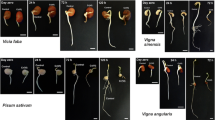Abstract
THE antimitotic action of griseofulvin in plant and mammalian cells has been attributed to a colchicine-like disruption of microtubules. Treatment of Vicia faba, Allium root tips or HeLa cells with griseofulvin, for example, resulted in the accumulation of cells at metaphase1–3. The griseo-fulvin-inhibited cells contained abnormal arrays of chromosomes, identical to those produced by treatment of dividing cells with colchicine. Using polarization microscopy, Malawista et al.4 found that the addition of 10−5 M griseofulvin to dividing Pectinaria oocytes reduced the size of the nieiotic spindles, as measured by loss of birefringence. This action was considerably more rapid than with either podophyllotoxin or vinblastine sulphate; moreover, on removal of the griseofulvin, recovery of the spindle also occurred much more rapidly4. Recent evidence indicates that several of the drugs which arrest metaphase interfere with microtubule function through different mechanisms. Colchicine and the vinca alkaloids, for example, bind to tubulin (microtubule protein) at different molecular sites5,6. Griseofulvin does not prevent the binding of colchicine to tubulin, nor does it affect the ability of the vinca alkaloids to stabilize the colchicine binding activity of tubulin5. This suggests that griseofulvin does not bind at either the colchicine or vinca alkaloid binding sites.
Similar content being viewed by others
References
Paget, G. E., and Walpole, A. L., Nature, 182, 1320 (1958).
Deysson, G., Ann. pharm. franc., 22, 17 (1964).
Deysson, G., Ann. pharm. franc., 22, 89 (1964).
Malawista, S. E., Sato, H., and Bensch, K. G., Science, 160, 3829 (1968).
Wilson, L., Biochemistry, 9, 4999 (1970).
Bryan, J., Biochemistry, 11, 2611 (1972).
Weisenberg, R. C., Science, 177, 1104 (1972).
Borisy, G. G., and Olmsted, J. B., Science, 177, 1196 (1972).
Hepler, P. K., and Jackson, W. T., J. Cell Sci., 5, 727 (1969).
McIntosh, J. R., Hepler, P. K., and Van Wie, D. G., Nature, 244, 659 (1969).
Gordon, G. B., Miller, L. R., and Bensch, K. G., Exp. Cell Res., 31, 440 (1963).
Palade, G. E., J. Exp. Med., 95, 285 (1952).
Freeman, J., and Spurlock, B., J. Cell Biol., 13, 437 (1962).
Sjostrand, F. S., J. Ultrastruct. Res., 9, 340 (1963).
Reynolds, E. S., J. Cell Biol., 17, 208 (1963).
Mizel, S. B., and Wilson, L., Biochemistry, 11, 2573 (1972).
Author information
Authors and Affiliations
Rights and permissions
About this article
Cite this article
GRISHAM, L., WILSON, L. & BENSCH, K. Antimitotic Action of Griseofulvin does not Involve Disruption of Microtubules. Nature 244, 294–296 (1973). https://doi.org/10.1038/244294a0
Received:
Issue Date:
DOI: https://doi.org/10.1038/244294a0
- Springer Nature Limited
This article is cited by
-
Griseofulvin stabilizes microtubule dynamics, activates p53 and inhibits the proliferation of MCF-7 cells synergistically with vinblastine
BMC Cancer (2010)
-
The effect of griseofulvin on the gene regulation of β-tubulin in the dermatophyte pathogen Trichophyton rubrum
Journal of Infection and Chemotherapy (2007)
-
In vitro susceptibility ofTrichophyton rubrum isolates to griseofulvin and tioconazole. Induction and isolation of a resistant mutant to both antimycotic drugs
Mycopathologia (1996)





